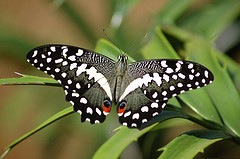 The Kenya Forest Service is one of the forces behind butterfly farming projects around the country. According to the latest KFS annual report (which I found out about from ASNS), household incomes have really benefited from the project, mostly by exporting butterfly pupae to collectors and butterfly farms abroad, mostly in the United States and the United Kingdom. The report, launched last week, says: 1
The Kenya Forest Service is one of the forces behind butterfly farming projects around the country. According to the latest KFS annual report (which I found out about from ASNS), household incomes have really benefited from the project, mostly by exporting butterfly pupae to collectors and butterfly farms abroad, mostly in the United States and the United Kingdom. The report, launched last week, says: 1
The butterfly farming project based at Arabuko-Sokoke forests is one of the various initiatives aimed at involving forest adjacent communities in conservation through sustainable utilization of forest resources to improve livelihoods. The community appreciates the role that the project has played in the improvement of their household income and the positive contribution impacted towards conservation and management of the forest.
We’ve written about butterfly and silk farming in Africa before and it is good to know that these projects do seem to be working. The primary impact is to preserve the forest, by giving local villagers an incentive to keep it intact as a new source of income. Digging around a bit, I found some more useful resources. David Ngala at Wildlife Direct had a post about the Kipepeo project, which links to the project’s own web site. All very worthwhile.
Photo, of Papilio demodocus, by Matt and Kim Rudge, used under a Creative Commons license.